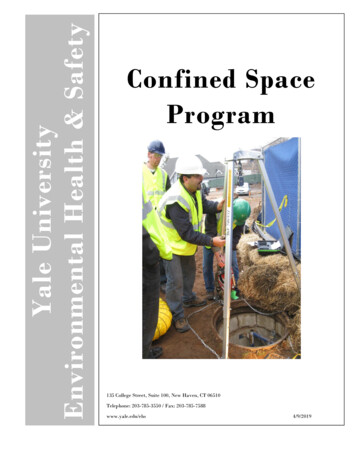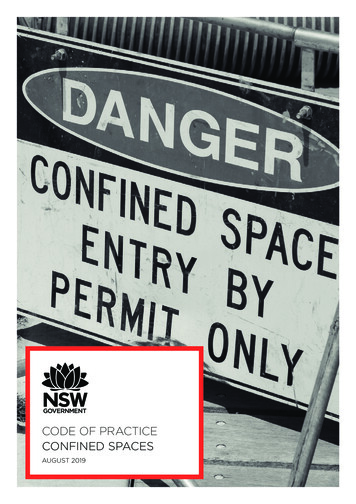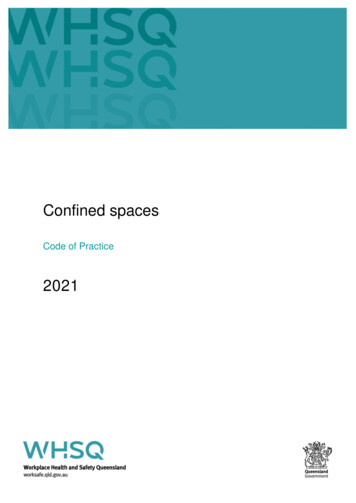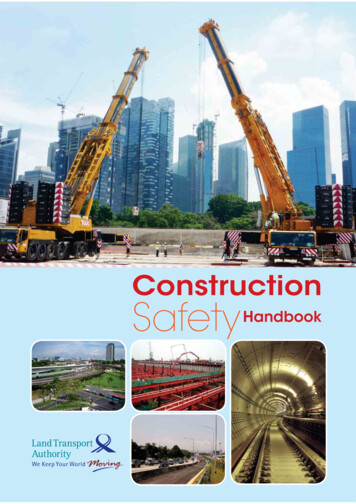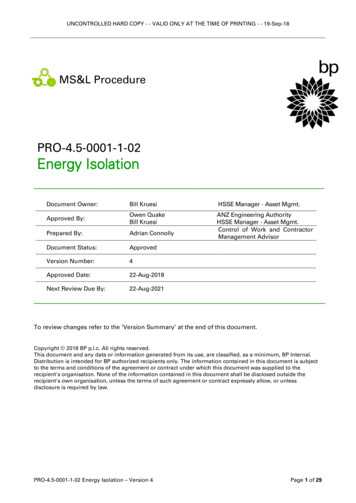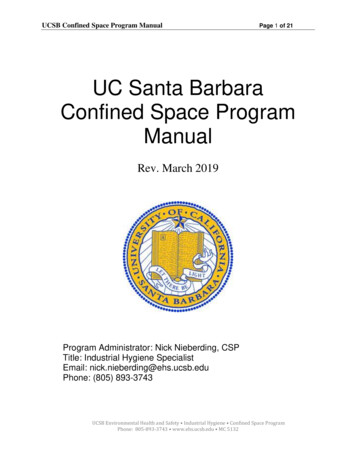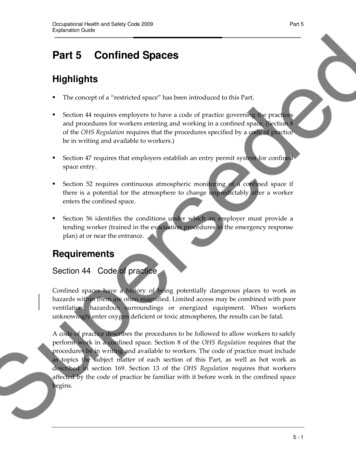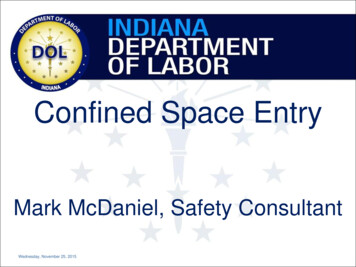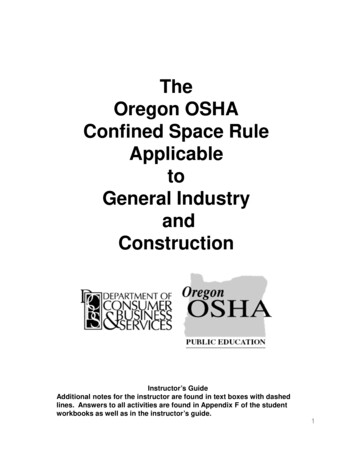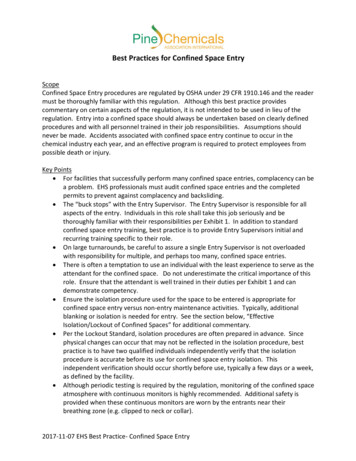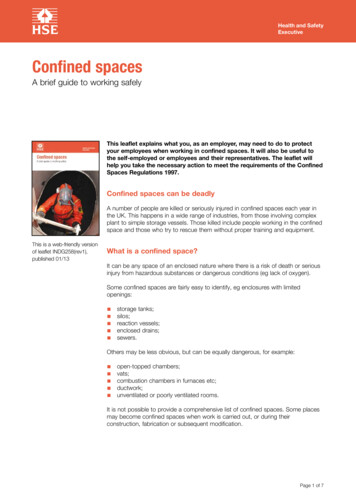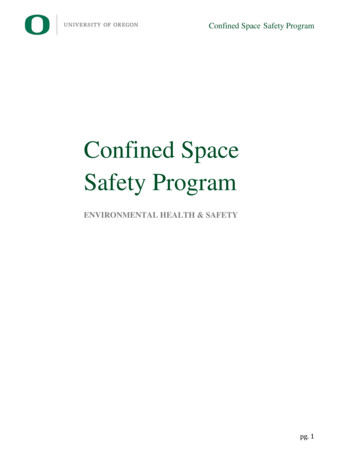
Transcription
Confined Space Safety ProgramConfined SpaceSafety ProgramENVIRONMENTAL HEALTH & SAFETYpg. 1
Confined Space Safety ProgramTable of ContentsA.Introduction And Purpose . 4B.Policy And Scope . 4C.Responsibilities . 41.Department . 42.Environment Health And Safety (EHS) . 53.Campus Ops And Other Departments Working In Confined Spaces . 54.Supervisor . 65.Contractor . 6D.Definitions . 7E.General Requirements. 11F.Permit System . 11G.Training And Duties Of Authorized Entrant . 12H.Training And Duties Of Authorized Attendant/Rescuer . 13I.Training And Duties Of The Individual Authorizing And/Or Persons(s) In ChargeOf The Entry . 14J.Rescue Team . 15K.Contractors . 15pg. 2
Confined Space Safety ProgramL.Utility Tunnel System . 16M.Basic Confined Space Scenario (Example Steps) . 16N.1.Pre-Entry. 162.Working In The Confined Space . 173.Completion Of Work . 17Program Review Documentation . 17pg. 3
Confined Space Safety ProgramConfined Space Safety ProgramA. INTRODUCTION AND PURPOSEThis written program is intended to describe the University of Oregon's (UO) Confined Space EntryProgram as required by the Oregon Occupational Safety and Health Administration (OR-OSHA) rulesSubdivision J, 1910.146. This plan will serve as the required written Confined Space Program for theUniversity of Oregon. An addendum to this written program includes a list of locations of identifiedConfined Spaces.A safe and successful Confined Space Entry requires preplanning. Preplanning includes identifyinganticipated hazards inside the Confined Spaces, selecting proper equipment to control the hazards,providing good documentation on the necessary controls via the written Permit System, providingappropriate training for everyone involved in the Entry, and rapidly responding to emergencysituations.Environment Health and Safety (EHS) consults with Departments and Supervisors to look at feasibleprecautions and required safeguards to prevent exposures to toxic gases, oxygen deficiency,flammable atmospheres, and accidents related to entering Confined Spaces. By identifying thehazards and providing the appropriate controls, a Confined Space can become a safe and routinepart of Employees’ everyday responsibilities.B. POLICY AND SCOPEThe following Program will apply to any UO Employee, Student, and/or Contractor employee thatmay enter into a space identified as a Confined Space. Contractors must have a Confined Spaceprogram at least equivalent to this Program and in accordance to applicable OR-OSHA related codes.This written Confined Space Program will be available on the UO web to any UO Departments withEmployees and/or Students, and Contractors prior to their entry into any Confined Spaces.Before any Employee becomes an Entrant or Attendant/Rescuer connected with Confined Spaces,they shall be trained by the UO EHS in their specific duties and familiar with Confined Space Entryprocedures, conducting pre- and continual atmosphere testing, hazard recognition, and evaluationand control of suspected or known hazards associated within a Confined Space, etc.C. RESPONSIBILITIES1. Department – Departments will be responsible for:a. Carrying out the Confined Space Entry Program elements in accordance with this WrittenProgram and relevant OR-OSHA Confined Space codes.b. For funding Program expenses including but not limited to Employee training andAttendant/Rescuer equipment expenses.pg. 4
Confined Space Safety Programc. Keeping EHS informed of new Employees who will need required training and requestingnecessary retraining.d. Enforcing compliance with the Confined Space Permit System and notifying EHS ofinfractions of the Confined Space Program so it can be evaluated to help preventreoccurrence.e. Notifying EHS upon discovery or creation of any new Confined Spaces.f.Those in the Department overseeing Contractors with their Subcontractors to consult andremind them that they are to follow the Contractor Responsibilities and the ContractorsSection “K” of this Confined Space Safety Program, along with any other OR-OSHA coderequirements.2. Environmental Health and Safety (EHS) – EHS will be responsible for:a. Administering and managing the Confined Space Entry Program.b. Assisting Departments in evaluating their compliance with the Confined Space EntryProgram.c. As notified by Entry Supervisors for the need, conduct training for Employees to beAuthorized Attendant/Rescuers, and Authorized Entrants.d. Notifying Departments/Supervisors of incidents during implementation of the UO ConfinedSpace Program by UO Employees, Contractors, and Subcontractors, etc.e. Maintaining general Confined Space training records.f.Designating Confined Space Authorizers.g. Maintaining the master list of Confined Spaces, Authorized Entrants, and AuthorizedAttendant/Rescuers. .h. When notified of the intention to enter a Confined Space by a Contractor, EHS will followrelated responsibilities in the Contractors Section “K” of this Confined Space Safety Program.i.Soliciting input from users, through their respective Supervisors, during the annual reviewprocess.j.Maintaining SCBA equipment.3. Campus Operations And Other Departments Working in Confined Spaces – Those Departmentsworking in Confined Spaces will be responsible:a. To provide Authorized Attendant/Rescuers where required for Permit-Required ConfinedSpace Entries at the expense of the Department that is requesting the entry if there is a costinvolved.b. To provide Authorized Entrants and Attendant/Rescuers for the Confined Space work detailwho have been trained by UO EHS.pg. 5
Confined Space Safety Programc. Will include purchasing and maintaining necessary equipment to perform retrievaloperations (with the exception of SCBA that will be maintained by EHS).4. Supervisor – Supervisors involved with Confined Space Entry will be responsible for:a. Identifying Employees who will enter defined Confined Spaces and notifying EHS for anyneed of the applicable training for Entrant or Attendant/Rescuer.b. Maintaining Employee job specific Confined Space training records.c. Assuring Employees are aware of and following this Written Program.d. Be responsible for Employees’ adherence to procedures that all operations remainconsistent with the terms of the Entry Permit, and that Entry conditions remain acceptablethroughout the process.e. Assessing hazards and determining if acceptable Entry conditions are present prior to Entrywhile taking into account the activities the Entrant is going to be doing.f. Immediately notifying EHS of any incidents that occur in connection with any ConfinedSpace Entry.g. Knowing the hazards that Entrants may be faced with during the Confined Space Entry.h. Providing information to Entrants and Attendant/Rescuers regarding the mode, symptoms,and consequences of exposures to hazards in the Space to be entered.i. Verify that the Permit, including all required provisions, has been completed prior to Entry.j. Terminate the Entry and cancel the Permit if any of the required provisions of the Permit arenot met or if additional hazards which affect the safety of the Entrants become apparent.k. Verify the designated Rescue equipment is available onsite as needed for the Entry torespond to an emergency.l. Enforce the removal of unauthorized people who enter or attempt to enter the ConfinedSpace.m. Whenever possible give the EHS Authorizer a 24-hour notice regarding the plan to enter aspecific Confined Space and job duties to be performed. This request is so the Permitpaperwork can be started and completed timely. Understandably there are emergenciesand other instances that much advanced notice is not practical.5. Contractor – Contractors involved with Confined Space Entry will be responsible for:a. Following the Contractor’s section of the UO Confined Space Safety Program.b. When is expected to perform work in a UO Confined Space, the Contractor will also followall required applicable OR-OSHA Confined Space codes.c. Having their own Confined Space Program and enter UO Confined Spaces under their ownPermit system.d. Upon request Contractors will be required to provide a copy of their Confined SpaceProgram to UO EHS.e. Prior to entry, informing EHS which space they plan to enter to do work and will give a copyof their Permit to EHS for recordkeeping purposes so EHS can inform them of suspected orknown hazards for that space.pg. 6
Confined Space Safety Programf.Posting a copy of the Permit at the entrance while working in that Confined Space inaccordance to OR-OSHA requirements.g. If a Contractor is going to enter any of the Confined Space Utility Tunnel System, theContractor is to follow all procedures outlined in the supplemental Utility Tunnel SafetyProgram and applicable tunnel related OR-OSHA Confined Space codes.h. Fulfilling the Hazard Communication Program requirements by:i. Having Safety Data Sheets on site for all hazardous chemicals that fall within thescope of the Hazard Communication Rules.ii. Mitigating possible health and physical hazards that might be created by bringthe chemicals into the Confined Space.iii. Providing a hazardous chemical list and copies of the Safety Data Sheets forthese chemicals if requested by EHS.iv. Removing any chemicals they bring on site when they are no longer needed.D. DEFINITIONS1. “Acceptable Entry Conditions” – means conditions that must exist in a Permit-RequiredConfined Space to allow Entry and to ensure that employees involved with the PRCS entry cansafely enter into and work within the space.2. "Authorized Attendant/Rescuer" – means an individual stationed outside the Permit-RequiredConfined Space that is trained as required by this standard and who monitors the AuthorizedEntrants inside the Permit-Required confined space. The Authorized Attendant/Rescuer is alsoresponsible to ensure that conditions required on the permit are met prior to Entry, overseeEntry operations, terminating Entry, and returning Permit to the Authorizer for debriefing andPermit termination. The Authorized Attendant/Rescuer will remain stationed outside the PRCSor as required by a non-PRCS during the Entry and remain there until work is completed orrelieved by another Authorized Attendant/Rescuer.3. "Authorized Entrant" – means an employee who is authorized by the employer and hasreceived appropriate training to enter a Confined Space.4. “Configuration” – means the internal shape or size of a Space. Be aware of inwardly convergingwalls or floors, which slope downward and taper to a smaller cross section.5. “Contractor” – means an outside company or individual as a general contractor orsubcontractor hired to do different kinds of new, repair, and/or maintenance work on the UOcampus.6. “Confined Space” – means any Space having a limited way of egress which is subject to theaccumulation of toxic or flammable contaminants or an oxygen deficient atmosphere, hasadequate size and configuration for employee Entry, and is not designed for continuousemployee occupancy. Confined Spaces include, but are not limited to, storage tanks, processvessels, silo, bins, boilers, ventilation or exhaust ducts, septic tanks, underground utility vaults,pg. 7
Confined Space Safety Programtunnels, pipelines, etc., and open top spaces more than 4 feet in depth, such as pits, tubes,vaults, or vessels.7. “Designated Entry Authorizer” – means a person who has been designated by EHS to authorizeEntry into a Confined Space with the issuance of a Permit or Information Sheet. This person hasreceived training as both an Authorized Entrant and Attendant/Rescuer.8. “Emergency” – means any occurrence (including any failure of hazard control or monitoringequipment) or event internal or external to the Permit Space that could endanger Entrants.9. “Energy Hazards” – means energy hazards involve contact with electrical equipment, steam orother sources of heat inside the Confined Space. This type or equipment can include shafts,augers, mixers or impellers.10. “Engulfment” – means the surrounding and effective capture of a person by a liquid or finelydivided solid substance that can be aspirated to cause death by filling or plugging the respiratorsystem or that can exert enough force on the body to cause death by strangulation, constriction,or crushing.11. “Entry” – means the act by which a person passes through an opening into a Confined Spaceand includes ensuing work activities in that space. The Entrant is considered to have entered assoon as any part of the Entrant’s body breaks the plane of an opening into the Space.12. “Entry Permit” – means the document placed at the opening to a Confined Space outlininglocation, equipment monitor readings, Entrant(s) entering, Attendant, times and date ofoperation, type of work going on in the Confined Space, etc.13. “Entry Supervisor” – means an Entrant’s Supervisor who for the purposes of an entry into aPRCS or non-PRCS, will serve as the person responsible for determining if acceptable entryconditions are present prior to entry while taking into account the activities the Entrant is goingto be doing, oversee Entry operations as needed, and is in compliance with the Permit andInformation Sheet documents.14. “Flammable (EXPLOSIVE) Atmosphere or Hazards” – means flammable or explosiveatmosphere contains gases, vapors or dusts in concentrations, greater than 10% of the LEL,which is high enough to ignite or explode. Common flammable atmospheres include methanegas, solvent vapors from tank residues, or combustible dusts such as grain dusts, flour, ormetallic paint pigments.15. “Hazard Communication Program” – means the Program to improve the level ofinformation provided to Employees and others regarding the chemicals that they mayencounter and handle during the course and scope of their work that can be health andphysical hazards.16. “Hazardous Atmosphere” – means an atmosphere which exposes employees to a risk of death,incapacitation, injury or acute illness from one or more of the following causes:a. A flammable gas, vapor or mist in excess of 10 percent of its lower flammable limit.pg. 8
Confined Space Safety Programb. An airborne combustible dust at a concentration that obscures vision at a distance of fivefeet or less.c. An atmospheric oxygen concentration below 19.5 percent or above 23.5 percent.d. An atmospheric concentration of any substance for which a permissible exposure limit (PEL)exists and could result in employee exposure in excess of its permissible limits.e. Any atmospheric condition recognized as immediately dangerous to life or health.17. “Hot Work Permit” – means the written authorization to perform operations (riveting, welding,cutting, burning, heating, etc.) that could provide a source of ignition. The Hot Work Permitinvolves an additional Permitting procedure outside the Permit-Required Confined Spaceprocess. This additional Permitting is required to be obtained by UO and non-UO employeeswhen these type of work activities are being performed anywhere on the UO Campus.18. “Immediately Dangerous To Life And Health” – means any condition that poses an immediateor delayed threat to life or that would cause irreversible adverse health effects or that wouldinterfere with an individual’s ability to escape unaided from a Permit Space.19. “Information Sheet” – means when a space is not a Permit-Required Confined Space there aredifferent entry instructions to follow that are less stringent, but not any less important to follow.20. “Isolation” – means the process by which a Permit-Required Confined Space is removed fromservice and completely protected against the release of energy and material into the space bysuch means as: blanking or blinding, misaligning or removing sections of lines, pipes, or ducts, adouble block and bleed system, Lockout/Tagout of all sources of energy, or blocking ordisconnecting all mechanical linkages.21. “LEL” – means Lower Flammable Limits (may also be seen as LEL or Lower Explosive Limit) offlammable liquids, gases and volatile solids.22. “Line Breaking” – means the intentional opening of a pipe, line, or duct that is or has beencarrying flammable, corrosive, or toxic material, an inert gas, or any fluid at a volume, pressure,or temperature capable of causing injury.23. “Non-Permit Confined Space” – means a Confined Space that does not contain or, with respectto atmospheric hazards, have the potential to contain any hazard capable of causing death orserious physical harm.24. “Other Hazards” – means when an employee enters a Confined Space, they are subject to awide variety of hazards which are unique to the Space or are magnified by the Confined Space.Other hazards can include falls due to loose rungs on fixed ladders in manholes, slipperysurfaces do to liquids in tanks or sloping floors, noise exposure due to sound reflected off ofwalls within the Space, personal protective equipment that is used improperly, or the specifictype of work being performed.25. “Oxygen Deficient Atmosphere” – means an atmosphere that contains less than 19.5% oxygenby volume.pg. 9
Confined Space Safety Program26. “Oxygen Enriched Atmosphere” – means an atmosphere containing more than 23.5 percentoxygen by volume.27. “Oxygen Hazards” – means too much oxygen in the air increases the potential for normally nonflammable materials such as grease, oil, or clothing to catch fire at normal temperature or whenexposed to sparks or flames. Atmospheres containing too little oxygen result in physical effectsto workers in the space. According to the OR-OSHA Standard the following are defined as highand low oxygen levels: 23.5% & above High Oxygen Levels, 20.8% to 21% Normal Oxygen Levelsfor Air 19.5% and below Low Oxygen Levels28. “Permit-Required Confined Space Program” – means UO’s overall program for controlling andprotecting employees from Permit-Required Space hazards and for regulating employee Entryinto Permit Spaces.29. “Permit-Required Confined Space or PRCS” – means consisting of any or all of the following:a. Is large enough and so configured that an Entrant can bodily enter and perform assignedwork.b. Has limited or restricted means for entry or exit (e.g. storage bins, vaults, pits).c. Is not designed for continuous Entrant occupancy and has one or more of the followingcharacteristics:i. Contains or has a known potential to contain a hazardous atmosphere.ii. Contains a material with the potential for engulfment of an Entrant.iii. Has an internal configuration such that an Entrant could be trapped or asphyxiated byinwardly converging walls, or a floor which slopes downward and tapers to a smallercross-section.d. Contains any other recognized serious safety or health hazard.30. “Permit System” – means UO’s written procedure for preparing and issuing Permits for Entryand for returning the Permit Space to service following termination of Entry.31. “PPM” – means parts per million of substances.32. “Prohibited Condition” – means any condition in a Permit Space that is not allowed by thePermit during the period when Entry is authorized (cutting, burning, etc.).33. “Retrieval System” – means the equipment (including a retrieval line, full body harness, and alifting device or anchor, etc.) used for non-Entry rescue of Entrants from Permit Spaces.34. “Safety Data Sheet” (SDS) – means a Hazard Communication Program standardizedGlobal Harmonizing System (GHS) written or printed material concerning a hazardouschemical specifics which is prepared by the chemical manufacturer.pg. 10
Confined Space Safety Program35. “Testing” – means the process by which the hazards that may confront Entrants of a PermitSpace are identified and evaluated. Testing includes specifying the tests that are to beperformed in the Permit Space.36. “TLV” – means Threshold Limit Value of toxic, corrosive or irritant contaminants.37. “Toxic Atmosphere or Hazards” – means an atmosphere that has contained liquids, vapors,gases or solids of toxic, corrosive, irritant nature (or if the Confined Space has been fumigated)that have poisonous effects. Greater than TLV level of specific toxic substance. Some toxicatmospheres are immediately fatal (IDLH). Other materials are less severe causing dizziness ornausea. Common toxic hazards include hydrogen sulfide, sulfur dioxide and carbon monoxide.38. “Training – Confined Space” – means the hazard awareness training provided by UO EHS forindividuals involved with entering and/or working around UO Confined Spaces. The training alsoincludes duties and responsibilities for Entrant, Attendant/Rescuer, Authorizer, and SupervisorResponsibilities Identifying Hazards in Confined Spaces.E. GENERAL REQUIREMENTSEHS will maintain an inventory of Confined Spaces. As any new Spaces are discovered or questionedas to whether the Space is a Permit-Required or Information Sheet Space, EHS will make the finaldetermination. Information regarding specific Spaces is also available. For specific Space definitions,see “Permit-Required Confined Space” listed above.Exposed employees will be informed of UO Confined Space by posted signs reading “DANGER –CONFINED SPACE. AUTHORIZED ENTRY ONLY”. In addition, Entrant and Attendant/Rescuer trainingwill include advising employees of the UO Permit-Required Confined Spaces, how to identify them ifthere is no sign posted and that all electrical vaults are considered Permit-Required ConfinedSpaces.F. PERMIT SYSTEMA Permit-Required Confined Space or non-Permit Required Confined Space Information Sheet isrequired to be obtained from a designated Entry Authorizer prior to Entry into any Space designatedas a Confined Space. The Tunnel System is a Confined Space, and a separate Confined Space Entryprocedure has been developed for them.Only an official UO Confined Space Permit/Information Sheet form will be used. The form will befully filled out before the Confined Space will be entered with the original form to be maintained onthe jobsite until the work shift and/or job is completed.Upon termination of the Entry covered by the Permit or Information Sheet, and after all Entrantshave exited the Confined Space, the individual authorizing the Entry will close the Permit orInformation Sheet. If the Entrant Supervisor is not at the jobsite the Attendant/Rescuer will close,date, and sign the Permit or Information Sheet.pg. 11
Confined Space Safety ProgramIn cases where the Entry Entrant Supervisor will not be present for the duration of the Entry andthere is no required Attendant/Rescuer, an Entry Coordinator among the Authorized Entrants will bedesignated by the Entrant Supervisor. In either case, the Entry Attendant/Rescuer or Supervisor willsign the form before the Entry begins, but not until all actions and conditions necessary for safeEntry into the Confined Space have been performed by the Entrant Supervisor.EHS will serve as the record keeper for the program; closed Information Sheets or Permits are to besent to EHS within 24 hours.G. TRAINING AND DUTIES OF AUTHORIZED ENTRANTPrior to being eligible to obtain an entry form, Authorized Entrants will be trained in the followingareas and will be required by the University to perform the following duties. This training can consistof lecture, videotape program, and a safety awareness test.1. Recognition of hazards which may be faced during an Entry. This includes the signs andsymptoms of an exposure to a hazard as well as an understanding of the consequences of thatexposure.2. When Attendant/Rescuers are required, Authorized Entrants will maintain communication withand notify the Attendant/Rescuer in the event the Entrants initiate evacuation. If an Entrant in aPRCS becomes aware that the Attendant/Rescuer is not present they will immediatelyevacuate.3. Authorized Entrants will be provided with and required to use appropriate personal protectiveequipment as designated by the Entry Authorizer, Supervisor and/or Attendant/Rescuer. Incases when respiratory protection is required, the Entrant must have evidence of current fittesting and training. Entrants will be instructed in the use of the designated personal protectiveequipment. Any external barriers needed to protect Entrants from external hazards will beexplained and used.4. Alert the Confined Space Attendant/Rescuer to order evacuation whenever:a. Behavioral effects of hazard exposure are observed in any Entrant.b. A prohibited condition is detected.5. When an Attendant/Rescuer is required, exit the Space when one of following occurs:a. Lockout/Tagout practices not followed.b. When the Attendant/Rescuer orders an evacuation.c. When an automatic alarm (e.g., gas meter, fire alarm) sounds.d. When the Authorized Entrant perceives that they are in danger.e. Note: The only exception to the Entrants following these directions would occur when theEntrant is unable physically to evacuate on their own power.pg. 12
Confined Space Safety ProgramAdditional training will be required for Entrants when there is a change in duties, there are Permitchanges which results in hazards for which the Entrant has not previously been trained or whenevernecessary.H. TRAINING AND DUTIES OF THE AUTHORIZED ATTENDANT/RESCUERPrior to being eligible to be an Authorized Attendant/Rescuer, employees will obtain training in thefollowing areas. This training can consist of lecture, videotape program, and a safety awareness test.1. Authorized Entrant training.2. Authorized Attendant/Rescuer Training.3. CPR/First Aid certification training.4. Receive instruction on and demonstrate proficiency with the evacuation equipment.5. Hazard recognition appropriate to the situations that Entrants may face in the Confined Space.6. Behavioral actions that may indicate lack of oxygen.Duties that will be the responsibility of Authorized Attendant/Rescuers include the following:1. Maintain an accurate count of all Entrants in the Space.2. Monitor activities inside and outside the Space to determine if it is safe for Entrants to remain inthe Space.3. Ensure Entrants are provided with and maintain an effective and continuous means of contactwith the Attendant/Rescuer during the Entry. This may range from voice communication toradio communication. Other means may be used as deemed appropriate and effective.4. All Attendant/Rescuers will have continuous radio communication capabilities with CampusOperations Control Room Operators as needed or required by this program. TheAttendant/Rescuer will notify the dispatcher when an evacuation is ordered due to imminentsafety hazards. In all ordered evacuations, the Authorizer will be notified immediately eitherthrough the Campus Operations Control Room Operator or UOPD dispatcher.5. The Attendant/Rescuer will order immediate evacuation of Entrants from Confined Spaces inthe following conditions:a. When the Attendant/Rescuer observes a condition which is not allowed in the entry form.b. The Attendant/Rescuer detects behavioral effects of hazard exposure.c. The Attendant/Rescuer detects a situation outside the Space which could endanger theEntrants.d. The Attendant/Rescuer detects an uncontrolled hazard within the Space.e. The Attendant/Rescuer must leave the workstation.pg. 13
Confined Space Safety Program6. The Attendant/Rescuer will take the following actions as necessary when an unauthorizedperson approaches or enters a Confined Space while Entry is underway:a. Warn the unauthorized person to exit immediately if they have entered the Space.b. Inform the Authorized Entrants, Entrant Supervisor, and the designated Authorizers if anunauthorized person entered the Space.7. Remain outside of the Confined Space. Attendant/Rescuers shall not enter the Space to attempta rescue of Entrants. Attendant/Rescuers that are part of the Rescue Team can only enter theSpace as a Rescuer when at least one other member of the Rescue Team is at the scene andthey are relinquished of their duties by another trained Authorized Attendant/Rescuer. At notime will the Entry site be left without a designated Attendant/Rescuer.Normally, Attendant/Rescuers will only be allowed to monitor one Space at a time. Exceptions tomonitoring mo
Confined Space Safety Program pg. 4 Confined Space Safety Program A. INTRODUCTION AND PURPOSE This written program is intended to describe the University of Oregon's (UO) Confined Space Entry Program as required by the Oregon Occupational Safety and Health Administration (OR-OSHA) rules Subdivision J, 1910.146. This plan will serve as the .
